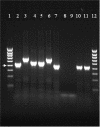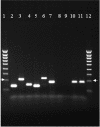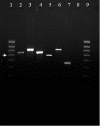Potential limitations of the 16S-23S rRNA intergenic region for molecular detection of Bartonella species
- PMID: 15750079
- PMCID: PMC1081238
- DOI: 10.1128/JCM.43.3.1171-1176.2005
Potential limitations of the 16S-23S rRNA intergenic region for molecular detection of Bartonella species
Abstract
PCR targeting the 16S-23S rRNA gene intergenic transcribed spacer (ITS) region has been proposed as a rapid and reliable method for the detection of Bartonella species DNA in clinical samples. Because of variation in ITS sequences among Bartonella species, a single PCR amplification can be used to detect different species within this genus. Therefore, by targeting the ITS region, multiple PCRs or additional sample-processing steps beyond the primary amplification can be avoided when attempting to achieve molecular diagnostic detection of Bartonella species. Although PCR amplification targeting this region is considered highly sensitive, amplification specificity obviously depends on primer design. We report evidence of nonspecific PCR amplification of Mesorhizobium species with previously published primers that were designed to amplify the Bartonella consensus ITS region. Use of these or other, less species-specific, primers could lead to a false-positive diagnostic test result when evaluating clinical samples. We also report the presence of Mesorhizobium species DNA as a contaminant in molecular-grade water, a series of homologous sequences in the ITS region that are common to Bartonella and Mesorhizobium species, the amplification of Mesorhizobium DNA with unpublished primers designed in our laboratory targeting the ITS region, and the subsequent design of unambiguous ITS primers that avoid nonspecific amplification of Mesorhizobium species. Our results define some potential limitations associated with the molecular detection of Bartonella species in patient samples and indicate that primer specificity is of critical importance if the ITS region is used as a diagnostic target for detection of Bartonella species.
Figures




Comment in
-
Potential limitations of the 16S-23S rRNA intergenic region for molecular detection of Bartonella species.J Clin Microbiol. 2005 Sep;43(9):4921-2. doi: 10.1128/JCM.43.9.4921-4922.2005. J Clin Microbiol. 2005. PMID: 16145180 Free PMC article. No abstract available.
Similar articles
-
Potential limitations of the 16S-23S rRNA intergenic region for molecular detection of Bartonella species.J Clin Microbiol. 2005 Sep;43(9):4921-2. doi: 10.1128/JCM.43.9.4921-4922.2005. J Clin Microbiol. 2005. PMID: 16145180 Free PMC article. No abstract available.
-
[Study on Bartonella infection using molecular biological diagnostic techniques from China].Zhonghua Liu Xing Bing Xue Za Zhi. 2004 Jul;25(7):602-6. Zhonghua Liu Xing Bing Xue Za Zhi. 2004. PMID: 15308042 Chinese.
-
Molecular method for Bartonella species identification in clinical and environmental samples.J Clin Microbiol. 2008 Feb;46(2):776-9. doi: 10.1128/JCM.01720-07. Epub 2007 Dec 19. J Clin Microbiol. 2008. PMID: 18094134 Free PMC article.
-
Detection of two Bartonella tamiae-like sequences in Amblyomma americanum (Acari: Ixodidae) using 16S-23S intergenic spacer region-specific primers.J Med Entomol. 2008 Jan;45(1):176-9. doi: 10.1603/0022-2585(2008)45[176:dotbts]2.0.co;2. J Med Entomol. 2008. PMID: 18283962
-
Application of Comparative Genomics for the Development of PCR Primers for the Detection of Harmful or Beneficial Microorganisms in Food: Mini-Review.Foods. 2025 Mar 20;14(6):1060. doi: 10.3390/foods14061060. Foods. 2025. PMID: 40232097 Free PMC article. Review.
Cited by
-
Assessment of a quantitative 5' nuclease real-time polymerase chain reaction using the nicotinamide adenine dinucleotide dehydrogenase gamma subunit (nuoG) for Bartonella species in domiciled and stray cats in Brazil.J Feline Med Surg. 2016 Oct;18(10):783-90. doi: 10.1177/1098612X15593787. Epub 2015 Jul 2. J Feline Med Surg. 2016. PMID: 26138812 Free PMC article.
-
Prevalence and diversity of small rodent-associated Bartonella species in Shangdang Basin, China.PLoS Negl Trop Dis. 2022 Jun 1;16(6):e0010446. doi: 10.1371/journal.pntd.0010446. eCollection 2022 Jun. PLoS Negl Trop Dis. 2022. PMID: 35648747 Free PMC article.
-
Blood culture-negative endocarditis caused by Bartonella quintana in Iran.Sci Rep. 2024 Oct 30;14(1):26063. doi: 10.1038/s41598-024-77757-0. Sci Rep. 2024. PMID: 39478136 Free PMC article.
-
Prevalence and genetic diversity of Bartonella spp. in wild small mammals from South Africa.Appl Environ Microbiol. 2024 Aug 21;90(8):e0084224. doi: 10.1128/aem.00842-24. Epub 2024 Jul 26. Appl Environ Microbiol. 2024. PMID: 39058027 Free PMC article.
-
Molecular Detection of Bartonella quintana among Long-Tailed Macaques (Macaca fascicularis) in Thailand.Pathogens. 2021 May 19;10(5):629. doi: 10.3390/pathogens10050629. Pathogens. 2021. PMID: 34069707 Free PMC article.
References
-
- Birtles, R. J. 1995. Differentiation of Bartonella species using restriction endonuclease analysis of PCR-amplified 16S rRNA genes. FEMS Microbiol. Lett. 129:261-266. - PubMed
-
- Birtles, R. J., and D. Raoult. 1996. Comparison of partial citrate-synthase gene (gltA) sequences for phylogenetic analysis of Bartonella species. Int. J. Syst. Bacteriol. 46:891-897. - PubMed
Publication types
MeSH terms
Substances
LinkOut - more resources
Full Text Sources
Other Literature Sources

